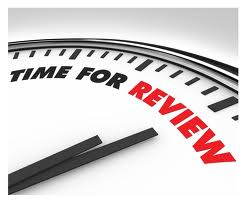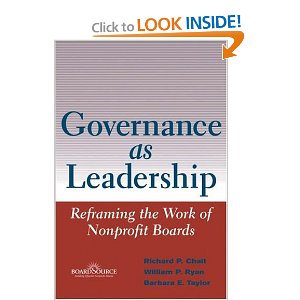 I was recently engaged in an engaging discussion about board development with a great group of non-profit board volunteers. The range of topics in that conversation spanned issues such as prospect identification, evaluation methods, prioritizing prospect lists, cultivating prospects, recruitment process, orientation, recognition, and evaluation. It was one of those conversations that a facilitator loves because everyone was engaged and actively participating. There was an energetic dynamic in the room, and then someone asked a really tough question:
I was recently engaged in an engaging discussion about board development with a great group of non-profit board volunteers. The range of topics in that conversation spanned issues such as prospect identification, evaluation methods, prioritizing prospect lists, cultivating prospects, recruitment process, orientation, recognition, and evaluation. It was one of those conversations that a facilitator loves because everyone was engaged and actively participating. There was an energetic dynamic in the room, and then someone asked a really tough question:
“How do we evaluate the scope of someone’s social network?”
This question stems from the discussion on the importance of diversity in your boardroom. After talking about the obvious (e.g. age, gender, ethnicity), these discussions always turn to the more difficult subjects including how to assess a prospective board volunteer’s social network and social capital. Of course, this is important because you don’t want a boardroom full of people who all walk in the same social circles.
Moreover, this is important because:
- Fundraising — The collective network in your boardroom is related to the reach of your fundraising program, its appeals and potential future donors.
- Board Development — Birds of a feather flock together, and the collective network in your boardroom will give birth to future boards. Board replicate themselves all the time!
- Group-think — People who are close and come from the same walks of life can sometimes think alike, which can greatly influence board governance and important decisions.
So, what is the answer to the aforementioned question pose by this obviously super smart board volunteer?
Well, it is complicated and simple all at the same time. Ugh!
 For decades (and probably centuries), board development committees have answered this question the old fashion way. They sat down around a table and talked it over. Those committees who were successful had a diversity of people sitting around the table and were able to assess a prospect’s social network in an anecdotal manner. They talked about what they see and hear about the prospect. Here are just some of the things they most likely talked through:
For decades (and probably centuries), board development committees have answered this question the old fashion way. They sat down around a table and talked it over. Those committees who were successful had a diversity of people sitting around the table and were able to assess a prospect’s social network in an anecdotal manner. They talked about what they see and hear about the prospect. Here are just some of the things they most likely talked through:
- Does the prospect sit on other non-profit boards?
- What church does this prospect belong to? Are they active? Who else belongs to that church?
- What other groups does this person belong to? (e.g. Rotary, Kiwanis, country club, chamber of commerce, local booster clubs, etc) Who else belongs to those groups?
- What else do we see this person’s name attached to? (e.g annual reports, donor recognition walls, local newspaper articles, etc)
- How does this prospect’s network, reach, and social capital compare to what is currently sitting around our boardroom table?
This is what “old school” board development assessment work looks like. It is highly effective. It has a track record of working. It is highly dependent on a diversity of people with a diversity of perspectives engaging in such a conversation.
Of course, our 21st Century mindset and perspectives leads us to question old approaches and investigate new tools and approaches, and there is nothing wrong with that.
So, I recently opened up my board development toolbox and re-examined some very traditional tools such as:
- board matrix
- sample prospective board member information sheet
- board candidate rating form
In doing that simple review, it occurred to me that there isn’t much substance to those tools from the perspective of assessing someone’s social network, social reach and social capital. The matrix does ask the board development committee to assess “community connections,” and the information sheet also asks questions about your prospect’s affiliations and other non-profit board service. While these tools nibble around the edges, it wouldn’t be difficult to tweak these tools to more directly address the question posed by our board volunteer at the beginning of this blog post.
 However, there are some “21st Century” tools that your board development committee might want to start using when talking through the issue of a prospect’s network. Consider the following:
However, there are some “21st Century” tools that your board development committee might want to start using when talking through the issue of a prospect’s network. Consider the following:
- Do a Google search on your prospective new board members during the evaluation phase of your process. Talk about the results of that search.
- Look at their online social networks (e.g. Facebook, LinkedIn, Twitter). If no one around the table is connected to the prospect in that way, then: 1) that might tell you something in and of itself and 2) you might expand your reach and find someone on the board or among your network who is linked in such a way.
- Use Guidestar to determine if they are associated with other non-profits in your community.
Of course, there is nothing wrong with the “old school approach”. In fact, one simple way that you can tweak this traditional approach is by including your prospective future board volunteers in the process. Asking them to help you answer a few questions about their network and their reach. If done appropriately, it wouldn’t have to feel awkward.
How does your non-profit organization tackle the question posed at the beginning of this blog post as part of its board development process? Please use the comment box to share your best practices. We can all learn from each other and save time by not re-inventing the wheel. 😉
Here’s to your health!
Erik Anderson
Founder & President, The Healthy Non-Profit LLC
www.thehealthynonprofit.com
erik@thehealthynonprofit.com
http://twitter.com/#!/eanderson847
http://www.facebook.com/eanderson847
http://www.linkedin.com/in/erikanderson847

 It’s the end of the year, which always seems like a good time to take stock. Did I meet my obligations? Did I rise to the occasion? Did I do what I said I would? Have I become what I aspired to be? Am I living an authentic life?
It’s the end of the year, which always seems like a good time to take stock. Did I meet my obligations? Did I rise to the occasion? Did I do what I said I would? Have I become what I aspired to be? Am I living an authentic life?
 For the last few weeks, I’ve found myself in a number of non-profit boardrooms talking to board volunteers about a variety of difficult subjects. These difficult conversations covered the following areas uncomfortable areas: staff reduction, re-organization, service reduction, radical revenue enhancement, board transformation, and so on. In each instance, it felt like a “soul-searching” discussion . . . very big and very weighty. I found myself wishing for a magic pill that I could dispense that would make their path forward a little less difficult.
For the last few weeks, I’ve found myself in a number of non-profit boardrooms talking to board volunteers about a variety of difficult subjects. These difficult conversations covered the following areas uncomfortable areas: staff reduction, re-organization, service reduction, radical revenue enhancement, board transformation, and so on. In each instance, it felt like a “soul-searching” discussion . . . very big and very weighty. I found myself wishing for a magic pill that I could dispense that would make their path forward a little less difficult. So, one organizations might find some comfort in their shared values of:
So, one organizations might find some comfort in their shared values of:













